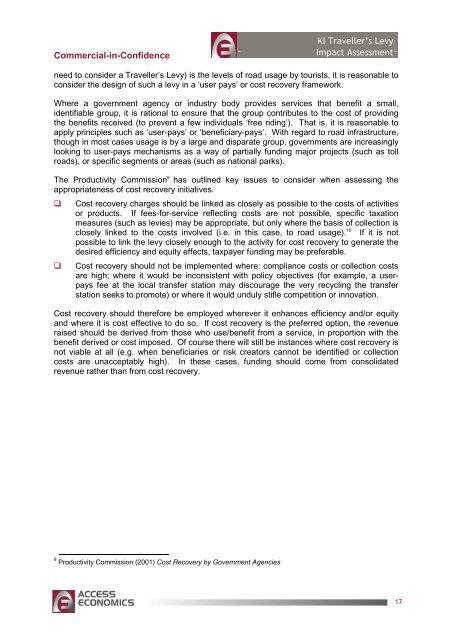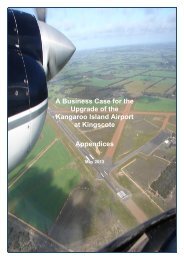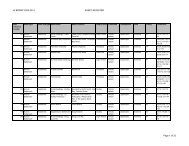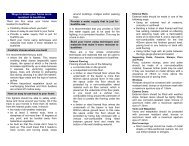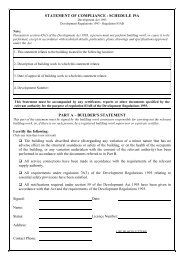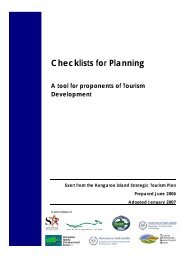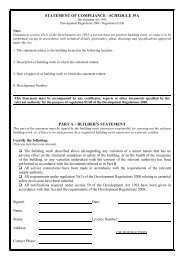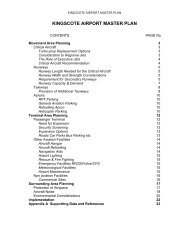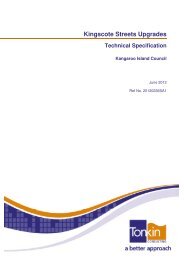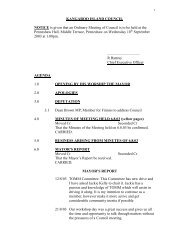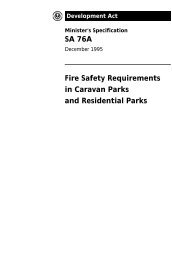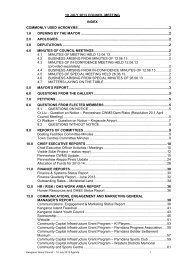KI Traveller's Levy Economic Impact Assessment - Kangaroo Island ...
KI Traveller's Levy Economic Impact Assessment - Kangaroo Island ...
KI Traveller's Levy Economic Impact Assessment - Kangaroo Island ...
You also want an ePaper? Increase the reach of your titles
YUMPU automatically turns print PDFs into web optimized ePapers that Google loves.
Commercial-in-Confidence<br />
<strong>KI</strong> Traveller’s <strong>Levy</strong><br />
<strong>Impact</strong> <strong>Assessment</strong><br />
need to consider a Traveller’s <strong>Levy</strong>) is the levels of road usage by tourists, it is reasonable to<br />
consider the design of such a levy in a ‘user pays’ or cost recovery framework.<br />
Where a government agency or industry body provides services that benefit a small,<br />
identifiable group, it is rational to ensure that the group contributes to the cost of providing<br />
the benefits received (to prevent a few individuals ‘free riding’). That is, it is reasonable to<br />
apply principles such as ‘user-pays’ or ‘beneficiary-pays’. With regard to road infrastructure,<br />
though in most cases usage is by a large and disparate group, governments are increasingly<br />
looking to user-pays mechanisms as a way of partially funding major projects (such as toll<br />
roads), or specific segments or areas (such as national parks).<br />
The Productivity Commission 9 has outlined key issues to consider when assessing the<br />
appropriateness of cost recovery initiatives.<br />
<br />
<br />
Cost recovery charges should be linked as closely as possible to the costs of activities<br />
or products. If fees-for-service reflecting costs are not possible, specific taxation<br />
measures (such as levies) may be appropriate, but only where the basis of collection is<br />
closely linked to the costs involved (i.e. in this case, to road usage). 10 If it is not<br />
possible to link the levy closely enough to the activity for cost recovery to generate the<br />
desired efficiency and equity effects, taxpayer funding may be preferable.<br />
Cost recovery should not be implemented where: compliance costs or collection costs<br />
are high; where it would be inconsistent with policy objectives (for example, a userpays<br />
fee at the local transfer station may discourage the very recycling the transfer<br />
station seeks to promote) or where it would unduly stifle competition or innovation.<br />
Cost recovery should therefore be employed wherever it enhances efficiency and/or equity<br />
and where it is cost effective to do so. If cost recovery is the preferred option, the revenue<br />
raised should be derived from those who use/benefit from a service, in proportion with the<br />
benefit derived or cost imposed. Of course there will still be instances where cost recovery is<br />
not viable at all (e.g. when beneficiaries or risk creators cannot be identified or collection<br />
costs are unacceptably high). In these cases, funding should come from consolidated<br />
revenue rather than from cost recovery.<br />
9 Productivity Commission (2001) Cost Recovery by Government Agencies<br />
17


